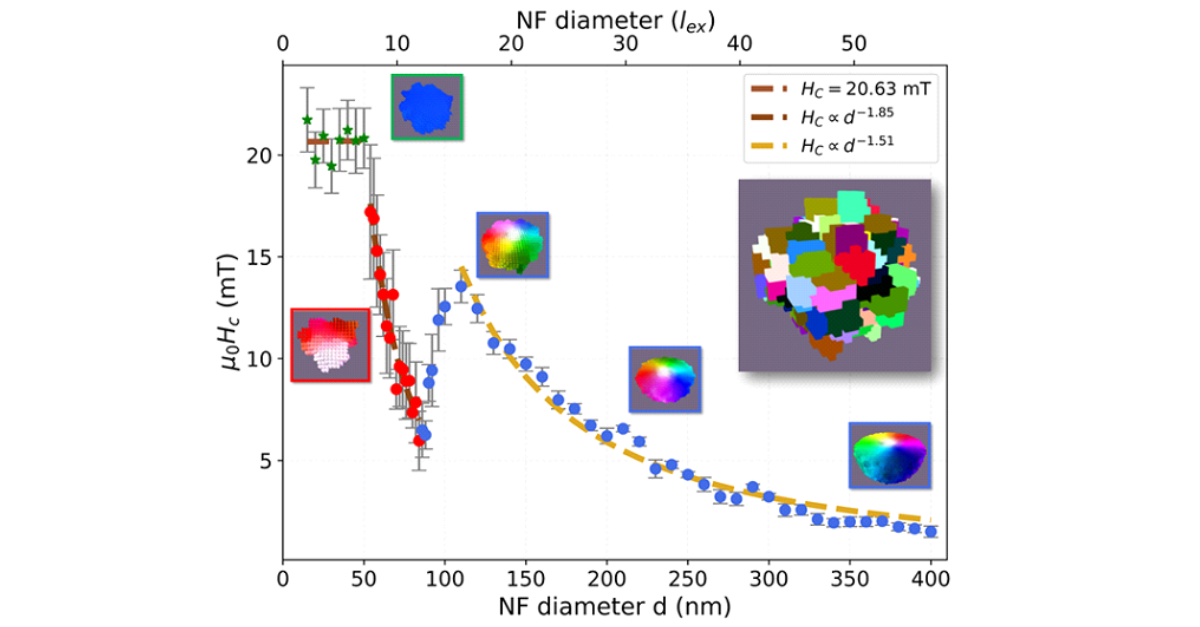
Coercivity-size map of magnetic nanoflowers: spin disorder tunes the vortex reversal mechanism and tailors the hyperthermia sweet spot
August 7, 2025. Imagine you need to repair a misfunctioning pipe. You take your toolbox, put your cap and boots on, and approach the breakdown area. You would need to have a look over the damage, and eventually, approach the part that is causing the failure, to in-situ proceed to repair. Human body works exactly the same, with the exception that the failure area-repairing agent size ratio is upside down. The first sticking point to overcome is to find a solution on how small a doctor can be. And for this, the field of nanomagnetism excels on its own. In the last decades, the miniaturization of magnetic materials, in the form of thin films, nanowires, and also, nanoparticles, has become a reality. Scientist can not only make nanoparticles smaller and smaller, yet they have learnt how to tune their magnetic properties, rendering them ideal tools for diagnosis and therapeutic applications. Within the latter, magnetic hyperthermia has been proposed as a therapy capable of selectively heating cancerous cells, debilitating altering their activity, to successfully remove tumors. This non-invasive therapy requires biocompatible excellent nanoheaters, in order to inject the minimum effective dose to the patient within the safety health limits. Maximizing the heating efficiency of magnetic nanoparticles for pushing the limits of hyperthermia treatment remains an open challenge.
To this aim, Dr. Elizabeth M Jefremovas, MSCA-YIA postdoctoral fellow supervised by Prof. Andreas Michels (Nanomag group), is studying the magnetization dynamics and heat release in iron oxide nanoparticles, core aim of her project “HYPUSH”. More precisely, HYPUSH aims to understand the role of spin disorder in magnetic nanoparticles, bridging inhomogeneities at the nanoparticle microstructure level (how the magnetic moments are aligned within the nanoparticle) to the macroscopic heat release.
A big milestone has been recently achieved as part of this project. In collaboration with Lisa Calus and Prof. Dr. Jonathan Leliaert, from the University of Gent, in Belgium, researchers have been able to resolve the magnetization dynamics in the so-called “nanoflowers”, multicore aggregates of iron oxide cores, rich in internal boundaries that act as source of spin disorder. For this, the researchers have ran more than 1000 simulations to calculate the microstructure of nanoparticles ranging from 10 to 400 nm in diameter, supported by the computational power provided by the high-performance computing facility (HPC) of the University of Luxembourg, the TIER-1 and TIER-2 infrastructures hosted by HPC-University of Ghent, and the additional support of the MeluXina supercomputer, key strategic facility empowering Luxembourg’s scientific ecosystem with scalable, state-of-the-art computational capacity for next-generation research.
Their scientific work, available in the public repository ArXiv following the link: https://arxiv.org/pdf/2507.02154 , successfully captures the “hyperthermia sweet spot”, a size windows around 100-200 nm where the coercivity of the nanoflowers, and therefore, their heat release, achieves a maximum.

By following the magnetization reversal, the researchers elucidated that there are actually two, and not only one, magnetization reversal paths, depending on the nanoparticle’s size, and this describes whether the coercivity raises with size, or continuously drops until being almost negligible. The comparison over different degrees of intra-particle disorder disclosed that this parameter shifts the threshold between the two reversal mechanisms, and therefore, can be used as a parameter to tune the nanoparticle size at which the heat release is maximized.
Next to this work, Dr. Jefremovas, with the support and guidance of Prof. Michels and Prof. Leliaert, is already engaged to determine how the magnetization dynamics, and therefore, the heat release, is affected when an AC magnetic field, similar to the one of clinical applications, is applied to the nanoparticles, with the aim to bring the knowledge close to real applications.
The MeluXina Impact
This research question is already running in the MeluXina supercomputer, in the form of 30.000 GPU hours over three months time. Time, and MeluXina, will provide an answer rendering their proposal one step closer to clinical applications.
Acknowledgements
E.M.J. acknowledges funding from the European Union’s Horizon 2020 research and innovation program under the Marie Sklodowska-Curie Actions grant agreement 101081455 — YIA; the Institute for Advanced Studies (IAS) of the University of Luxembourg; and the Fonds Wetenschappelijk Onderzoek(FWO-Vlaanderen) project number V501325N.
J. L. is supported by the FWO-Vlaanderen with senior postdoctoral research fellowship No. 12W7622N.
The computational resources and services used in this work were provided by the VSC (Flemish Supercomputer Center), funded by the Research Foundation Flanders (FWO) and the Flemish Government – department EWI; and from the HPC facilities of the University of Luxembourg and the Luxembourg national supercomputer MeluXina.


